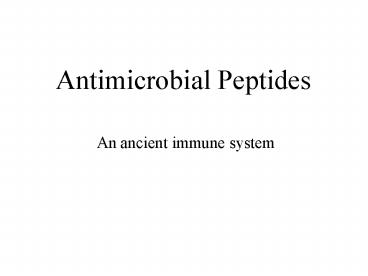Antimicrobial Peptides - PowerPoint PPT Presentation
1 / 16
Title:
Antimicrobial Peptides
Description:
An ancient immune system Small proteins of cationic charge involved in host innate immune defense Antimicrobial peptides: Where are they? In everything from Amoebas ... – PowerPoint PPT presentation
Number of Views:404
Avg rating:3.0/5.0
Title: Antimicrobial Peptides
1
Antimicrobial Peptides
- An ancient immune system
2
Antimicrobial peptidesWhat are they?
- Small proteins of cationic charge involved in
host innate immune defense
3
Antimicrobial peptidesWhere are they?
- In everything from Amoebas to Humans (incl.
Bacteria), - Abundant in vertebrates in
- External Mucosa
- eyes, mouth, genitourinary, skin, lung, trachea
- Circulating cells
- Neutrophils, platelets
- Intestinal tract (duodenum)
- in humans Paneth cells are the source
4
The principal defense molecules secreted by
Paneth cells are alpha-defensins, also known as
cryptdins. Paneth cells are stimulated to
secrete defensins when exposed to bacteria (both
Gram positive and negative types) or bacterial
products (lipopolysaccharide, muramyl dipeptide
and lipid A). In addition to defensins, Paneth
cells secrete lysozyme and phospholipase A2, both
of which have clear antimicrobial activity.
This battery of secretory molecules gives
Paneth cells a potent arsenal against a broad
spectrum of agents, including bacteria, fungi and
even some enveloped viruses (gastrointestinal
barrier).
5
Ouelette, Infect and Immun 1999, 67 6643
Immunohistochemistryshowing Cryptidin 4 in Paneth
cell secretory granules (A,B). C and D are the
controls to the experiment to show specificity
(peimmune serum/preadsorption).
6
Antimicrobial peptidesWhat do they do?
- Antifungal (Candida, Cryptococcus, Aspergillus)
- Antiparasitic (Malaria, Leishmania, Trypanosoma)
- Antibacterial
- Gram positive
- Gram negative
- Antiviral (Herpesvirus, influenza virus, HIV)
- ! They are chemotactic.
7
Antimicrobial peptidesWhy are they picky?
- Bacteria have
- more negative charge
- recall peptides are cationic
- no sterols, little phosphatidylcholine
8
Antimicrobial peptidesHow are they made?
- NF?B-type genetic element seems universal
- like acute phase response in humans
- The propiece is cleaved upon delivery of molecule
to phagosome (host protection?)
signal
propiece
mature
9
Yount et al., J. Biol. Chem. 274, 26249-26258,
1999
Immunohistochemical staining of BNBD-12.
Cytospin preparations of peripheral blood
leukocytes (A and B) and bone marrow cells (C and
D) were incubated with anti-BNBD-12 IgG (A and C)
or preimmune IgG (B and D). A, peripheral
leukocytes. All cells shown are neutrophils
except the three eosinophils (E). B, negative
control staining of leukocytes using preimmune
IgG as the first antibody. C, BNBD-12
immunoreactivity in neutrophilic precursors. A
spectrum of cells at different stages of
maturation is shown. MB, myeloblast PM,
promyelocyte MC, myelocyte MMC, metamyelocyte
NB neutrophilic band. D, Staining of bone marrow
cells using preimmune IgG as the first antibody.
10
Antimicrobial peptides are found stored in
granules but can also be de novo synthesised
upon stimulation with e.g. E.coli/LPS,
triggering through Toll-like Receptors.
11
Antimicrobial peptidesWhat do they do exactly?
12
The basis of specifity
13
Antimicrobial peptidesHow do they work?
- Acute inflammation
- Killing of bacteria, release of bacterial
inflammatory mediators (LPS, LTA), regulation of
macrophage response - adherence of PMN and chemotaxis, stimulation of
mast cells to release histamine. - fibroblast growth and adherence, apoptosis of
viral- or bacteria- infected host cells,
inhibition of fibrin clot lysis (thereby limiting
bacterial spread), inhibition of proteases (thus
limiting tissue injury).
- Chronic inflammation
- Recruitment of T cells, enhancement of
monocyte chemotaxis, - regulation of macrophage response.
14
Antimicrobial peptidesHow important are they
really?
- Defensins Wilson et al., Science 1999, 286113
- Mice with genetically engineered deficiency of a
metalloproteinase (needed for extracellular
cleavage and activation of a-defensins) show
increased susceptibility to bacterial infection - Cathelicidins Bals et al., Infect Immun 1999,
676084 - In a mouse model of septicemia, LL-37 binds to
and neutralises LPS and protects against
endotoxic shock. - Histatins Nishikata et al., Biochem Biophys Res
Commun. 1991174625 - role in protection from periodontal disease by
inhibiting protease of B. gingivalis
15
- SUMMARY
- Antimicrobial peptides are found in our mucosa
and neutrophil granules and act on phospholipids
in cell membranes via their hydrophobic and
positively-charged domains. - Defensin molecules insert into membranes, where
they interact with one another to form pores that
disrupt membrane function, leading to cell
killing. - Due to the higher concentration of
negatively-charged phospholipids in bacterial
membranes than vertebrate membranes, defensins
preferentially bind to and disrupt bacterial
cells. - Clinical Application
- Antimicrobial peptides are tested in clinical
trials for treatment of - Acne, oral candidiasis.
- !!Bacteria have evolved countermeasures to the
action of antimicrobial peptides (changes in wall
composition, transporter systems).
16
Reading recommendation
Robert Bals Epithelial antimicrobial peptides
in host defense against infection. Review. Respir
Res 2000, 1141-150































